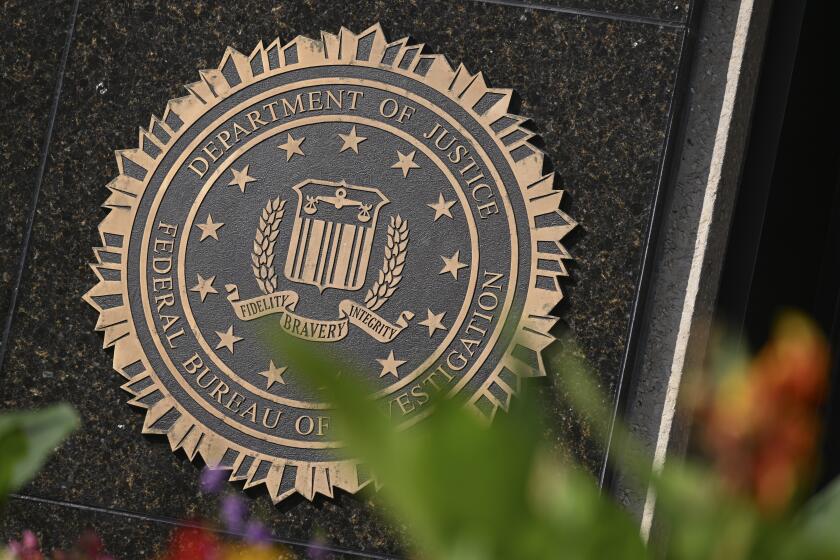Train, ship soot to be cut 90% by 2030
The U.S. Environmental Protection Agency on Friday unveiled proposals to slash diesel soot from freight trains and marine vessels by 90% by 2030, winning guarded praise from environmentalists, but a scathing rebuke from Southern California’s top air quality regulator.
Under rules announced by EPA Administrator Stephen Johnson, existing and new train locomotives would have to meet increasingly tougher controls on emissions of nitrogen oxide and fine particulate matter. Both substances lodge deep in people’s lungs and have been linked in numerous studies to respiratory disease, cancer and other serious health problems.
For the record:
12:00 a.m. March 12, 2007 For The Record
Los Angeles Times Monday March 12, 2007 Home Edition Main News Part A Page 2 National Desk 1 inches; 62 words Type of Material: Correction
Diesel regulations: An article in the March 3 California section about proposed federal regulations to reduce soot from diesel locomotives erred in paraphrasing a statement by Union Pacific spokesman Mark Davis. Davis said the company had worked for years with manufacturers to develop cleaner technology for locomotives, not that it would take years to develop technology to meet the proposed new rules.
Johnson said the regulations, which he would push to have completed by year’s end, would result in thousands of saved lives and substantial healthcare cost savings by 2030, while costing industry about $600 million.
“By tackling the greatest remaining source of diesel emissions, we’re keeping our nation’s clean-air progress moving full steam ahead,” he said. “This will ensure that black puff of smoke from diesel locomotives goes the way of the steam engine.”
But South Coast Air Quality Management District Executive Officer Barry Wallerstein said the region was “being thrown table scraps” with rules designed to benefit industry, which will allow thousands of Californians to continue to die prematurely for decades.
Greater Los Angeles is exposed to pollution from diesel engines more than anywhere in the nation, with 40% of all goods shipped to the U.S. funneled through the ports of Los Angeles and Long Beach on diesel-powered ships and trains. The air that Southern Californians breathe contains more than half of all the diesel particulate emitted in the U.S. each year. Air regulators estimate that 2,400 lives are cut short annually statewide because of pollution from the movement of goods.
State air officials also questioned the lengthy phase-in, saying it would not help them meet looming air-quality deadlines imposed by the EPA.
“We are grateful ... but we are disappointed in their timing. It makes it really hard for us to meet federal attainment requirements,” said Mike Scheible, deputy executive officer of the state Air Resources Board.
William Wehrum, acting assistant administrator of the EPA’s office of air and radiation, responded to that criticism by noting that existing engines that are rebuilt would be required to reduce emissions as soon as next year, and by 2010 at the latest.
“Then our standards get increasingly stringent, with the most stringent standards effective on all new engines as of 2015,” he added. “We’re going to begin seeing improvements very quickly, substantial improvements.”
Both Wehrum and Johnson acknowledged that because locomotives can last as long as 40 years, it could take until 2030 for the full benefits of the new rules to be seen.
Absent from the EPA proposals are regulations on large diesel engines in ocean-going vessels. EPA officials said they are trying to negotiate international standards for those heavily polluting vessels, and are still studying whether national regulations could legally be placed on foreign-flagged vessels entering American ports. Ferries, tugboats, yachts and marine auxiliary engines would be covered under the new rules, however.
Manufacturers and trade groups said the technology to meet the new rules does not yet fully exist but is being actively researched. They insisted they want further reductions in emissions and said the 2030 timeline for final compliance would help.
“There are some concerns about whether the locomotive manufacturers will be able to meet ... the standards, but we are committed to working with the locomotive builders and after-market manufacturers to do everything practical to reduce locomotive emissions,” said Burlington Northern Santa Fe spokeswoman Lena Kent.
But Wallerstein said that the technology does exist, and that the industry groups were dragging their heels to save money at the expense of public health.
“In Europe they are putting particulate filters on locomotives today,” he said, adding that the AQMD is funding demonstration programs of the technology on commuter trains because the freight railroads “have delayed and delayed and delayed.... this is a technology transfer, not the creation of new technology.”
Mark Davis, a spokesman for Union Pacific, said the company is already replacing most of the “switcher” engines in Los Angeles-area rail yards with a new technology using truck engines, but said it would take years to develop new technology for long-haul locomotives.
Environmentalists who have fought for three years for the rules largely cheered the news. Fred Krupp, president of Environmental Defense, who stood at Johnson’s side as he announced the regulation at Port Elizabeth in New Jersey, said later, “It’s very good, it’s very strong, and it would take an enormous amount of ... pollution out of the air. We were there to thank Steve Johnson and the EPA for getting on the right track.”
He said the lack of regulations on marine vessels was “unfinished business” that must be addressed. As for the AQMD’s concerns, he said, “well, it does take time for the manufacturers to retool.” He said he thought most emissions reductions would be achieved by 2015, before California has to meet EPA deadlines.
Others said they would keep a close eye on the proposals as they move through public hearings and rewrites.
“There are many details of this proposal yet to be worked out -- and we hope EPA can accelerate the pace of cleanup -- but this proposal is a giant step in the right direction,” said Frank O’Donnell of Clean Air Watch in Washington, D.C.
Representatives of international marine shippers did not return calls seeking comment.
More to Read
Sign up for Essential California
The most important California stories and recommendations in your inbox every morning.
You may occasionally receive promotional content from the Los Angeles Times.










